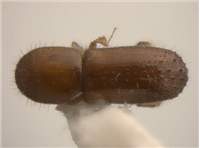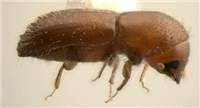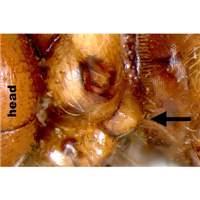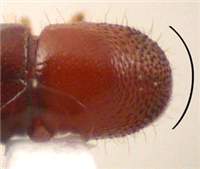Diagnosis
Middle-sized, elongated, light-colored. Antennal club type 2, with segment 1 dominant on posterior side but not covering it all. Protibia obliquely triangular. Prosternal posterocoxal process inflated.
These are the most common xyleborines in tropical and subtropical localities worldwide. Their species and genus limits are not clear.
Distribution
Global distribution, mostly tropical and temperate, rarely boreal.
Biology
Most species broadly polyphagous, excavating extensive tunnels without communal chambers.
Taxonomy
The genus Xyleborus is a taxonomic "dump basket" in xyleborina, including hundreds of unrelated species. In this information resource, we focus on a subset of the species which do share morphological characters and have been shown to be monophyletic in a molecular phylogeny: Xyleborus s. str. Users are likely to encounter numerous species named Xyleborus with no real phylogenetic affiliation to Xyleborus s. str., whose placement awaits examination.
Detailed description
The following description applies only to Xyleborus s. str. (Hulcr & Cognato 2010), a well-defined and monophyletic genus, not to the large polyphyletic "dump basket" of xyleborines with unclear placement.
Eyes shallowly or deeply emarginate, upper part smaller than lower part. Antennal club approximately circular, club type two (obliquely truncated, pubescent segment 2 partly visible on posterior side). Segment 1 prominent, covering most of anterior and nearly all posterior side, its margin concave, fully costate. Segment 2 visible on both sides, soft, or partly corneous on anterior side. Segment 3 absent from or partly visible on posterior side. Segment 1 of antennal funicle shorter than pedicel, funicle 4-segmented, scapus regularly thick. Frons above epistoma rugged, coarsely punctate. Submentum deeply impressed, shaped as very narrow triangle. Anterior edge of pronotum with no conspicuous row of serrations (serrations no different than on pronotal slope). Pronotum from lateral view of basic shape (type 0), or elongated, with low summit (type 7), from dorsal view basic, short, parallel-sided, rounded frontally (type 2). Pronotal disc shining or smoothly alutaceous, with small punctures, lateral edge of pronotum obliquely costate. Procoxae contiguous, prosternal posterocoxal process inflated, rounded, not pointed. Xyleborus s. str. have mandibular mycangia (Hulcr, unpubl.), thus no tuft on pronotal basis associated with mesonotal mycangium, and no setae on elytral bases associated with elytral mycangium. Scutellum flat, flush with elytra. Elytral bases straight, with oblique edge, elytral disc longer than declivity, flat; elytral disc with distinct lines of strial punctures. Lateral profile of elytral declivity mostly flat or slightly convex, steep in some species, especially towards apex, dorsal profile of elytral apex rounded, not broadened posterolaterally. Posterolateral declivital costa absent or very short. Elytral declivity with few setae, not conspicuously pubescent, inner part of declivity with several tubercles on interstriae 1, 3 and beyond, and no tubercles on interstria 2. Tubercles on interstriae 1 sometimes reduced to minor granules or absent, tubercles on interstriae 3 always prominent. First interstriae parallel, or parallel on disc but broadened towards apex of elytra. Protibiae obliquely triangular, broadest at 2/3 of length, or distinctly triangular, slender on upper part, broad and denticulate on lower part. Posterior side of protibia flat, no granules, only setae. Protibial denticles large, distinctly longer than wide, bases of denticles slightly or distinctly enlarged, conical; fewer than 6 protibial denticles present. Uniformly beige, brown or reddish, never black. Length: 2.1-3 mm.




